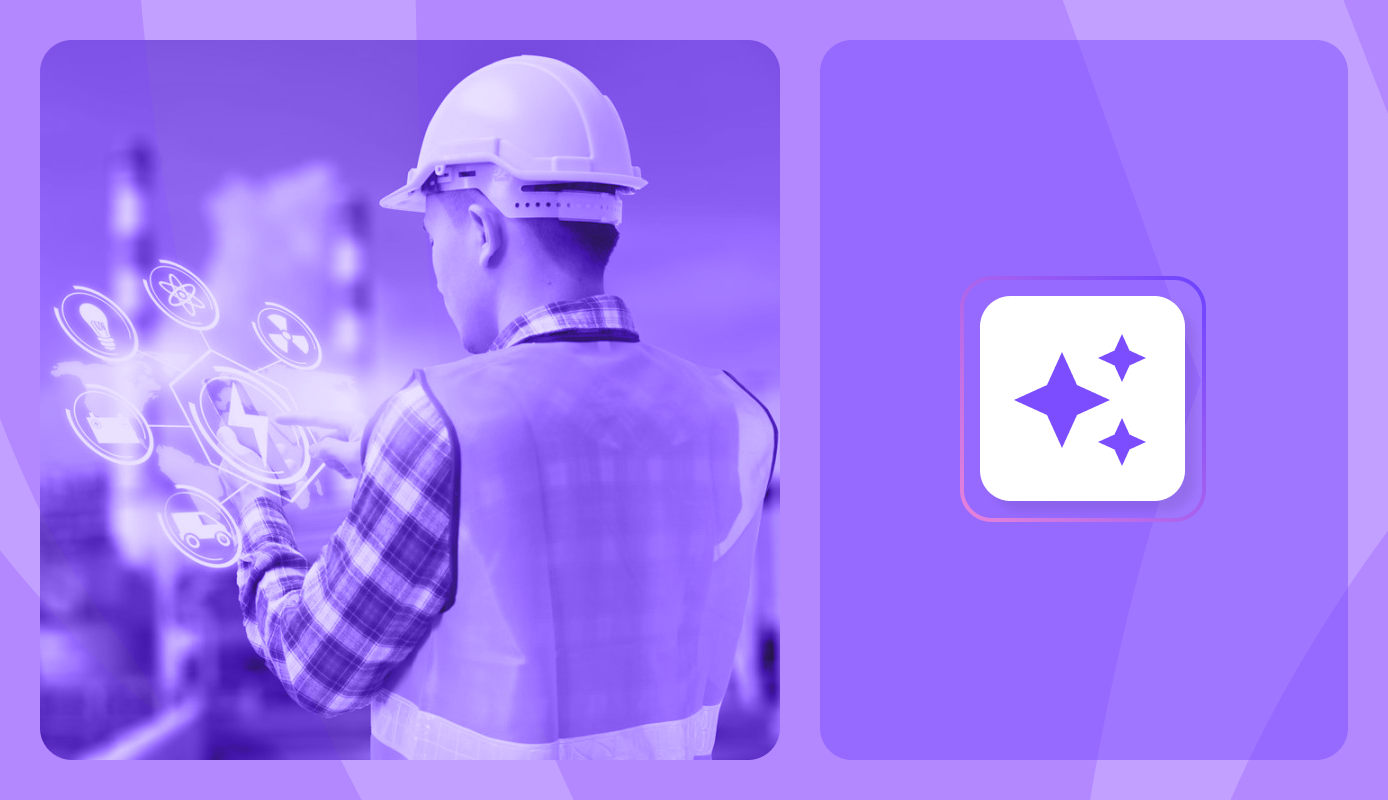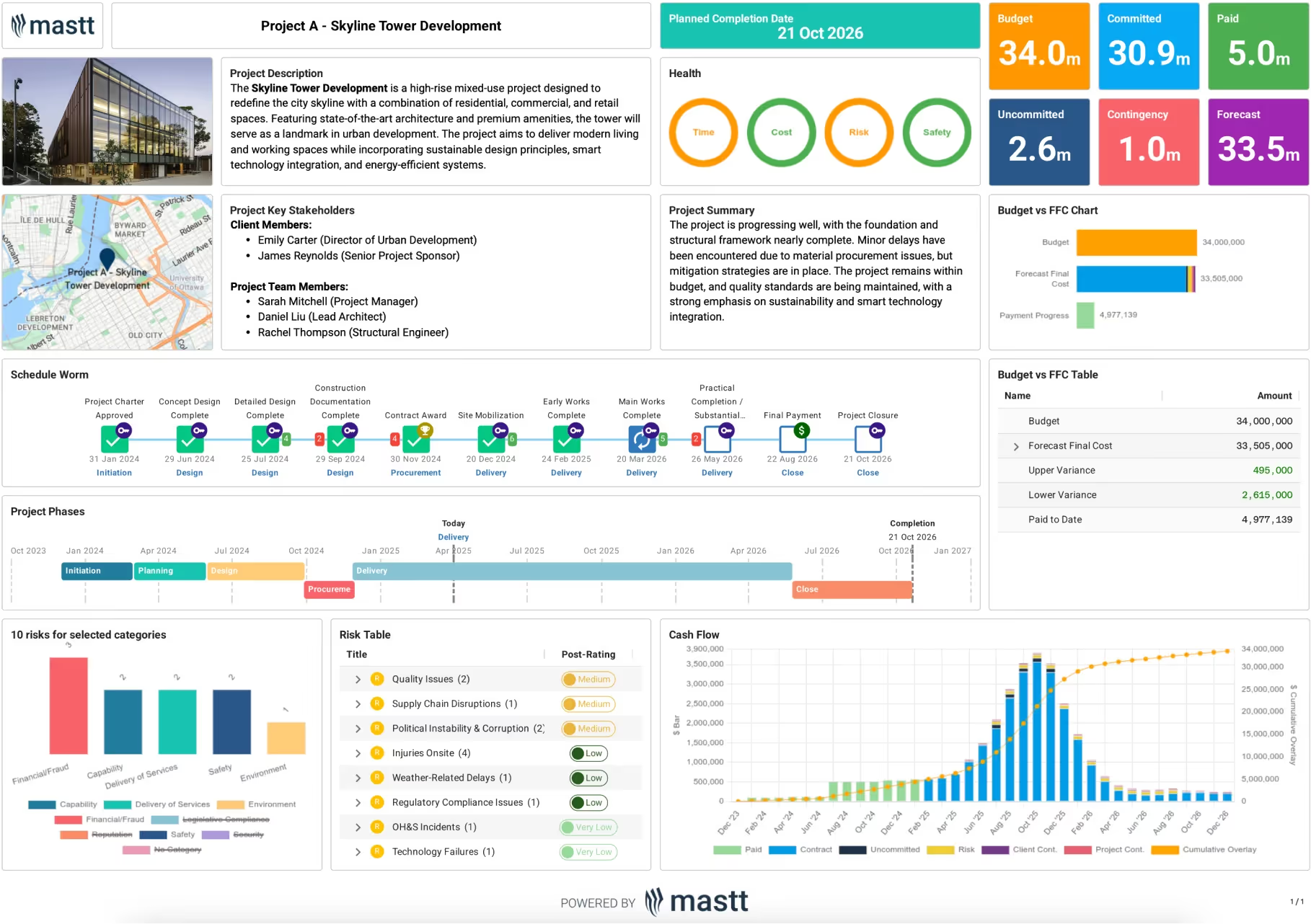AI use cases in construction are growing rapidly as project teams turn to automation and data-driven insights to deliver work more efficiently. Mastt’s AI in Construction research found that more than half of professionals already use AI to automate reports, manage data, and make faster, better decisions.
The biggest gains appear in reporting, cost control, document management, and risk management, where AI (artificial intelligence) improves accuracy and reduces manual effort. The following use cases highlight how AI is transforming the way construction projects are planned, managed, and delivered.
Intelligent Document, Design, and BIM Management for Better Control
Managing design and construction documents is now faster and more reliable with AI tools. By reading construction drawings, extracting key data, and identifying inconsistencies, AI minimizes rework and improves collaboration across teams. Document quality rises as design intent, compliance, and version control become fully transparent.
1. Document Q&A and Smart Search to Find Project Information Instantly
AI-powered search tools transform how teams access project information. They understand context, not just keywords, allowing users to locate files, correspondence, or data within seconds. The system learns from search behavior to deliver more relevant results over time.
Example: Project teams used Mastt AI Document Analysis to upload large reports and drawings, ask targeted questions, and instantly locate relevant information without hours of manual searching.
2. Design and Plan Review for Early Detection of Coordination Issues
Computer vision is one of the fastest-growing AI in construction use cases. Computer vision scans drawings and 3D models to identify design inconsistencies or coordination clashes. It analyzes geometry, dimensions, and layouts faster than manual reviews. By catching problems early, the system helps reduce rework and design errors.
Example: A design coordination platform uses AI to compare architectural and structural models, highlighting overlapping components before construction begins.
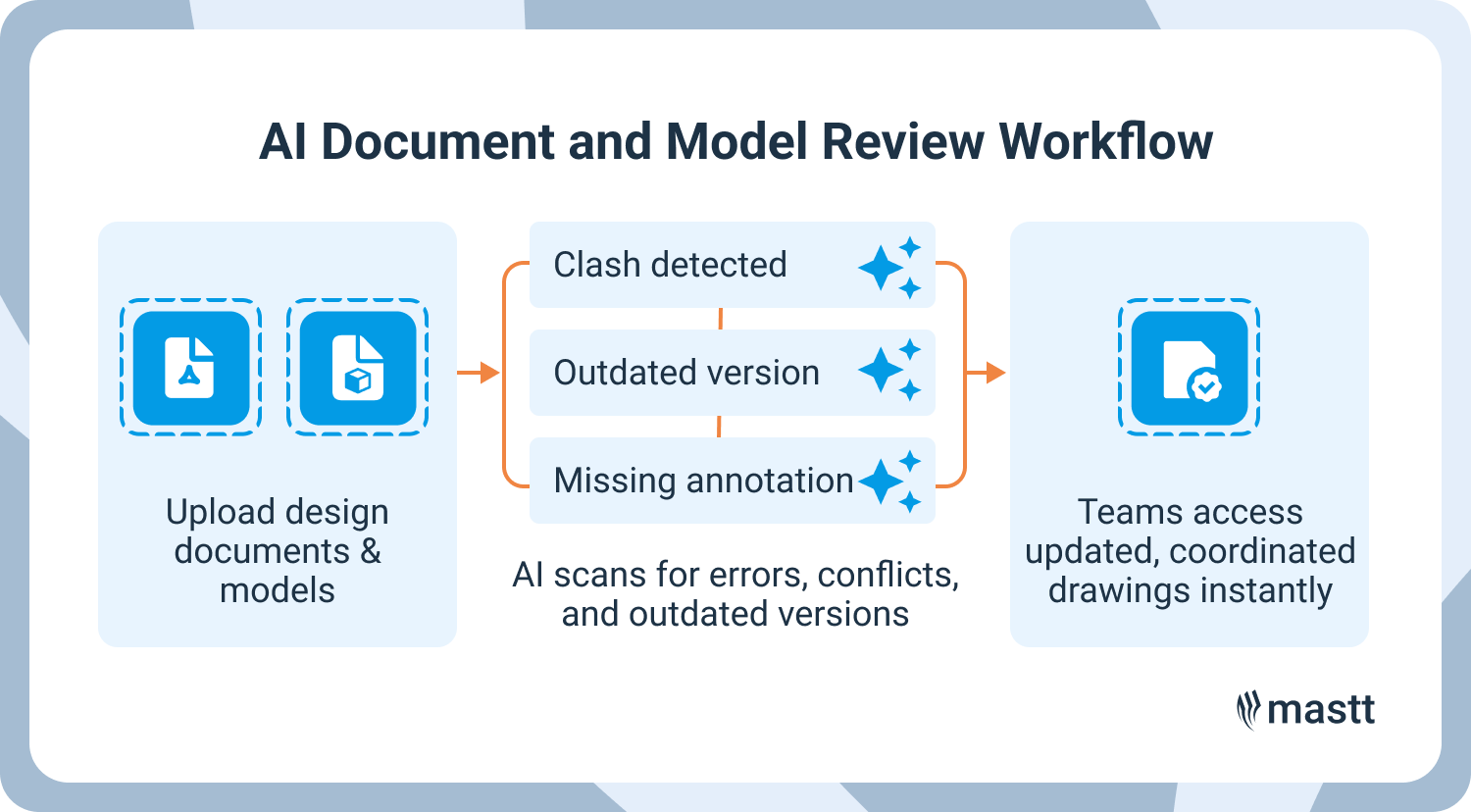
3. Document Quality Checker to Maintain Document Accuracy
AI document tracking tools automatically monitor changes across files and versions. They detect updates, flag outdated documents, and ensure everyone is working with up-to-date information. This prevents confusion and minimizes costly mistakes caused by version errors.
Example: An intelligent tracker notifies the team when a new revision of a drawing is uploaded and automatically updates references across all linked documents.
AI Contracts and Change Control for Faster, Smarter Management
Contract management with AI automates review and comparison tasks. By reading contract language, comparing versions, and tracking change history, AI ensures every clause and adjustment aligns with obligations. Contract administration becomes faster, more accurate, and far less dependent on manual interpretation.
4. AI Contract Upload and Query to Find Critical Details Instantly
AI-powered search makes contract navigation fast and precise. It uses natural language understanding to locate specific clauses, obligations, or dates across lengthy documents. Users can ask questions in plain English and receive targeted answers within seconds.
Example: A contract manager types, “What is the payment term for Vendor A?” in Mastt AI Contract Review, and it instantly highlights the relevant clause in the document.
5. AI Change Order Assessment That Streamlines Change Order Reviews
AI automation accelerates change order review by extracting key details, comparing them with existing contract terms, and identifying inconsistencies. It reduces manual workload while improving accuracy in change evaluation.
Example: A change order arrives, and the AI tool automatically checks it against the original scope and pricing, flagging changes that require further review.
6. Contract Comparison and Amendment Detection That Highlights What’s Changed
AI comparison tools detect subtle changes between contract versions. They highlight wording differences, added clauses, or removed terms that may otherwise go unnoticed. This ensures transparency during negotiations and approvals.
Example: Before signing an updated contract, an AI comparison engine pinpoints a newly inserted liability clause that was not in the previous version.
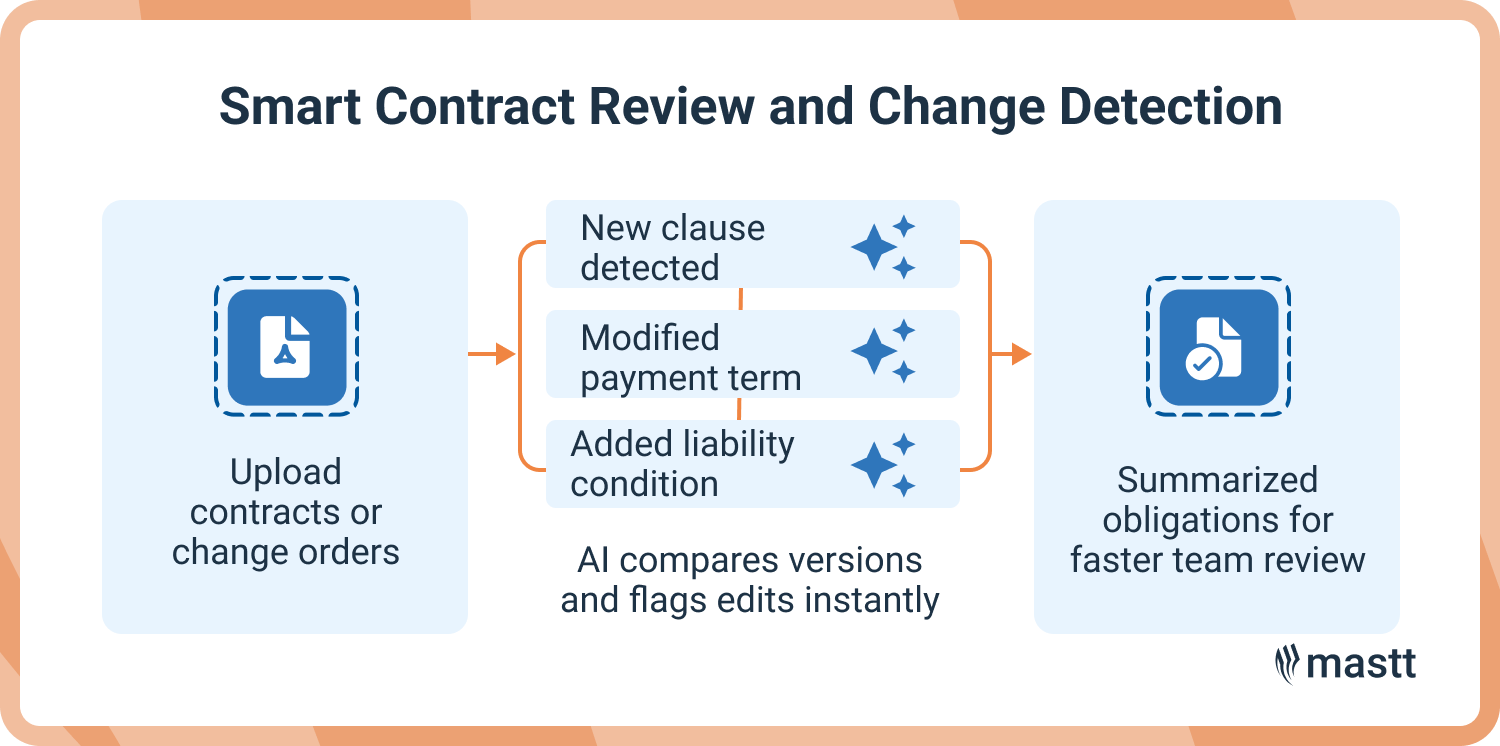
7. EOT Assessment to Validate Legitimate Time Extensions
AI predictive models assess extension of time (EOT) requests using objective data. They evaluate schedule records, delays, and correspondence to determine if requests are reasonable. This promotes fair, data-driven decision-making.
Example: A predictive AI system reviews delay reports and weather data, confirming that an EOT request is justified based on documented site conditions.
8. Contract Clause Simplifier for Plain-Language Summaries
AI language models convert complex contract text into concise, easy-to-understand summaries. They maintain accuracy while removing unnecessary legal jargon, helping project teams grasp obligations quickly.
Example: With Mastt AI Contract Review, a project manager uploads a 200-page contract, and the system instantly summarizes each section into clear, plain-language paragraphs outlining responsibilities, timelines, and penalties.
AI-Powered Cost Control for Smarter Financial Management
Cost management in construction projects is becoming more accurate with the help of AI and predictive analytics. By connecting live financial data with forecasting models, AI removes guesswork, shortens approval cycles, and improves confidence in every dollar spent in construction.
9. Pay App Checker to Verify Payments and Compliance
AI automation simplifies payment verification by checking invoices and progress payments against contracts and budgets. It automatically cross-references data to detect inconsistencies and ensure compliance with financial rules. This reduces the need for manual reviews and lowers the risk of payment errors.
Example: Mastt AI Payment Review checks payment requests against contract terms automatically, flagging discrepancies before approval.
10. AI Invoice Data Entry and Reconciliation to Match Invoices Automatically
AI systems streamline invoice processing through optical character recognition (OCR) and data matching algorithms. They extract key information from invoices and match it with purchase orders and delivery records in seconds. This eliminates repetitive data entry and ensures invoices are paid accurately and on time.
Example: Mastt AI Payment Review scans a supplier invoice, identifies missing details, and automatically cross-checks it against the project’s purchase order before approving payment.
11. Automated Cost Report Giving Instant Insight Into Project Spending
AI-powered integrations bring together live financial data from multiple platforms into one view. These systems sync cost data in real time, giving teams instant visibility into spending and budget performance. This digital connection enables faster, clearer, and more reliable cost management.
Example: An AI integration platform links accounting software, procurement systems, and project dashboards to show live cost status and upcoming financial commitments.
12. Forecasting and Scenario Analysis Identifying Future Cost Risks
Predictive analytics tools are among the most valuable AI in construction project management applications. AI predictive models analyze past financial performance and current spending trends to improve forecast accuracy. They highlight cost patterns, detect potential cost overruns, and suggest adjustments based on data-driven insights.
Example: An AI forecasting engine reviews historical budgets, identifies cost overruns from similar projects, and predicts when future expenses might exceed plan limits.

13. AI Budget and Cost Control Assistant Tracking Spend in Real Time
Machine learning enhances budget tracking by continuously learning from incoming cost data. It identifies trends, anomalies, and potential risks in real time. Over time, it improves accuracy by adapting to new financial conditions and project behaviors.
Example: A machine learning tool monitors project spend daily, flags unusual cost spikes, and automatically updates the remaining budget forecast.
14. Forecast Audit Automation to Detect Variances and Recommend Fixes
AI automation tools independently review financial forecasts against actual results. They identify variances, assess root causes, and suggest corrective actions to improve forecasting methods. This turns audits from reactive reviews into proactive learning processes.
Example: An AI audit assistant compares a project’s predicted and actual costs, detects repeated forecasting errors, and recommends data sources to improve future accuracy.
15. Real-Time Progress Tracking and S-Curve Automation to Visualize Spend and Progress
AI-powered auditing modules automatically assess forecast accuracy by comparing historical data, contract parameters, and S-curve performance trends. When assumptions or values fall outside normal thresholds, the system flags them for review. This creates a consistent, data-driven process that strengthens forecast integrity.
Example: An AI visualization tool connects time, cost, and performance data to create interactive charts showing where spending is ahead or behind plan.
Predictive AI in Risk and Assurance for Proactive Project Management
Among the most valuable AI use cases in construction, predictive risk management helps teams stay ahead of problems. By scanning correspondence, progress data, and financial reports, AI identifies warning signs that signal potential project risks. These insights help project managers make proactive decisions to prevent cost overruns, delays, and compliance issues.
16. AI Risk Assistant and Predictive Risk Register to Identify Risks Before They Escalate
AI predictive systems analyze extensive project data to detect early warning signs of potential risk. They uncover subtle trends in cost, schedule, or communication patterns that humans might miss. By flagging problems early, predictive tools allow teams to intervene before risks escalate into delays or cost overruns.
Example: An AI model scans weekly reports and identifies recurring supplier delays, prompting managers to review procurement plans before delivery timelines slip.
17. Instant Risk Registers That Update Automatically as Project Changes
AI keeps risk registers continuously updated by gathering insights from live project data. These intelligent systems pull information from progress reports, correspondence, and site updates to maintain a real-time view of project exposure. Teams can rely on accurate, up-to-date risk data without manual input or delays.
Example: A live risk register powered by AI automatically updates when a new issue appears in meeting notes, adjusting probability and impact scores instantly.
18. Automated Compliance Checklists for Checking Requirements in Real-Time
AI-driven automation brings consistency and accuracy to compliance tracking. It reviews documents, contracts, and certifications to confirm that requirements are being met. Instead of manual audits, project teams can depend on continuous, data-backed compliance verification.
Example: A compliance bot checks contractor insurance certificates against project records and sends reminders before expiration dates to prevent policy gaps.
19. AI Risk Suggestion Engine Predicting Where Future Risks May Arise
AI analytics engines learn from historical and current data to forecast new risks. They identify patterns that have previously led to issues, helping teams understand where challenges are most likely to occur. The insights support smarter planning and more informed decision-making.
Example: A predictive analytics tool reviews past project outcomes and warns that frequent design revisions could lead to cost escalation on a current job.

20. Real-Time Project Health Monitor That Tracks Performance Continuously
AI monitoring systems evaluate multiple performance metrics to keep project health visible at all times. They compare live progress data against baselines, highlight deviations, and recommend corrective actions. With this real-time intelligence, project teams can act quickly to maintain momentum.
Example: A data-driven monitoring platform detects a dip in productivity across several tasks and recommends reallocating resources to prevent schedule delays.
AI Scheduling and Planning Tools for Optimized Project Timelines
AI use case in scheduling and planning enhances the precision and adaptability of project programs. By analyzing live progress data, dependencies, and risks, AI models optimize schedules and simulate the impact of delays. Project teams gain the ability to predict, adjust, and replan efficiently, keeping projects on track.
21. AI Schedule Assistant Optimizing Plans and Adjusting to Changes
AI scheduling systems analyze task dependencies, resource availability, and performance data to build optimized schedules. They adapt dynamically as conditions change, keeping plans accurate and achievable. Teams gain a real-time view of progress without manually updating timelines.
Example: An AI scheduler detects that certain tasks are delayed, automatically reassigns resources, and updates the project plan to maintain the overall completion date.
22. AI Schedule Risk Identification to Predict Task Sequencing Issues
Predictive analytics improves scheduling by identifying weak links in the project plan. AI examines historical timelines, detects common bottlenecks, and suggests more efficient sequencing. With each project, the system becomes better at predicting how real-world events affect delivery times.
Example: A predictive scheduling tool flags dependencies that often cause delays and recommends a new order of tasks to minimize risk.
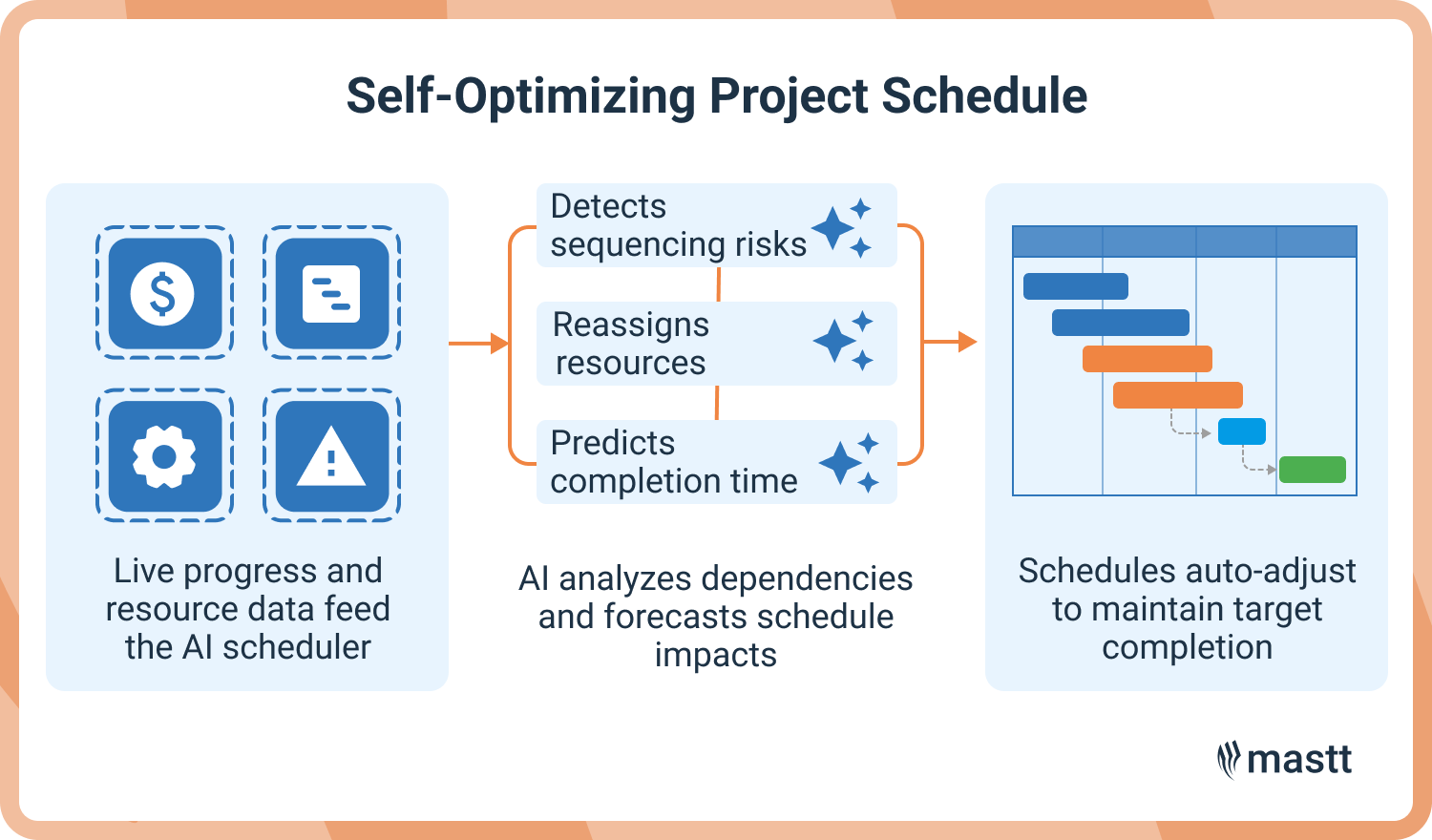
23. Project Timeline Generator That Turns Data Into Project Schedules
AI automation accelerates the creation of project timelines by analyzing scope details and past data. It automatically builds realistic schedules that account for task complexity and available resources. This allows managers to produce timelines in minutes rather than days.
Example: A project manager enters key milestones, and the AI tool instantly generates a detailed Gantt-style schedule with dependencies, durations, and critical paths.
Automated PM Co-Pilot and Admin Systems to Reduce Manual Work
One of the most practical AI use cases in the construction industry is automating administrative workflows to improve productivity. Workloads are shrinking as AI systems automate documentation, emails, and coordination tasks. AI anticipates actions, drafts correspondence, and manages project data with precision, helping teams deliver faster and with fewer errors.
24. AI PM Co-Pilot and Agent to Assist with Routine Tasks
AI-powered assistants simplify day-to-day project management by automating repetitive tasks. They schedule project meetings, send reminders, and generate drafts or summaries. These assistants learn work patterns to anticipate needs and help teams stay organized.
Example: Mastt’s AI Project Assistant drafts letters, summarizes documents, and automates admin work for teams.
25. AI Email and Correspondence Assistant That Sorts and Prioritizes Messages
AI email automation tools help teams manage large volumes of correspondence efficiently. They categorize emails, extract relevant data, and suggest quick responses. This minimizes inbox overload and keeps communication organized.
Example: An AI system scans incoming project emails, flags urgent messages, and automatically updates communication logs in the project’s central system.
26. Meeting Minute to Task Generator That Converts Notes Into Tasks
AI with speech recognition technology can capture meeting discussions and convert them into actionable tasks. It identifies decisions, assigns responsibilities, and updates project registers automatically. This ensures that nothing from a meeting is missed or forgotten.
Example: During a project meeting, an AI voice tool records the conversation, extracts action points, and adds them directly to the task tracker.
27. AI Assistant Email Inbox Sorting Messages by Context and Urgency
Smart inbox management systems use AI to prioritize and organize emails based on context and urgency. They group related threads, detect project-specific keywords, and recommend next steps. This helps teams focus on what truly matters instead of searching through endless messages.
Example: A smart inbox tool automatically moves contract-related emails into a shared folder and tags messages that require immediate approval.
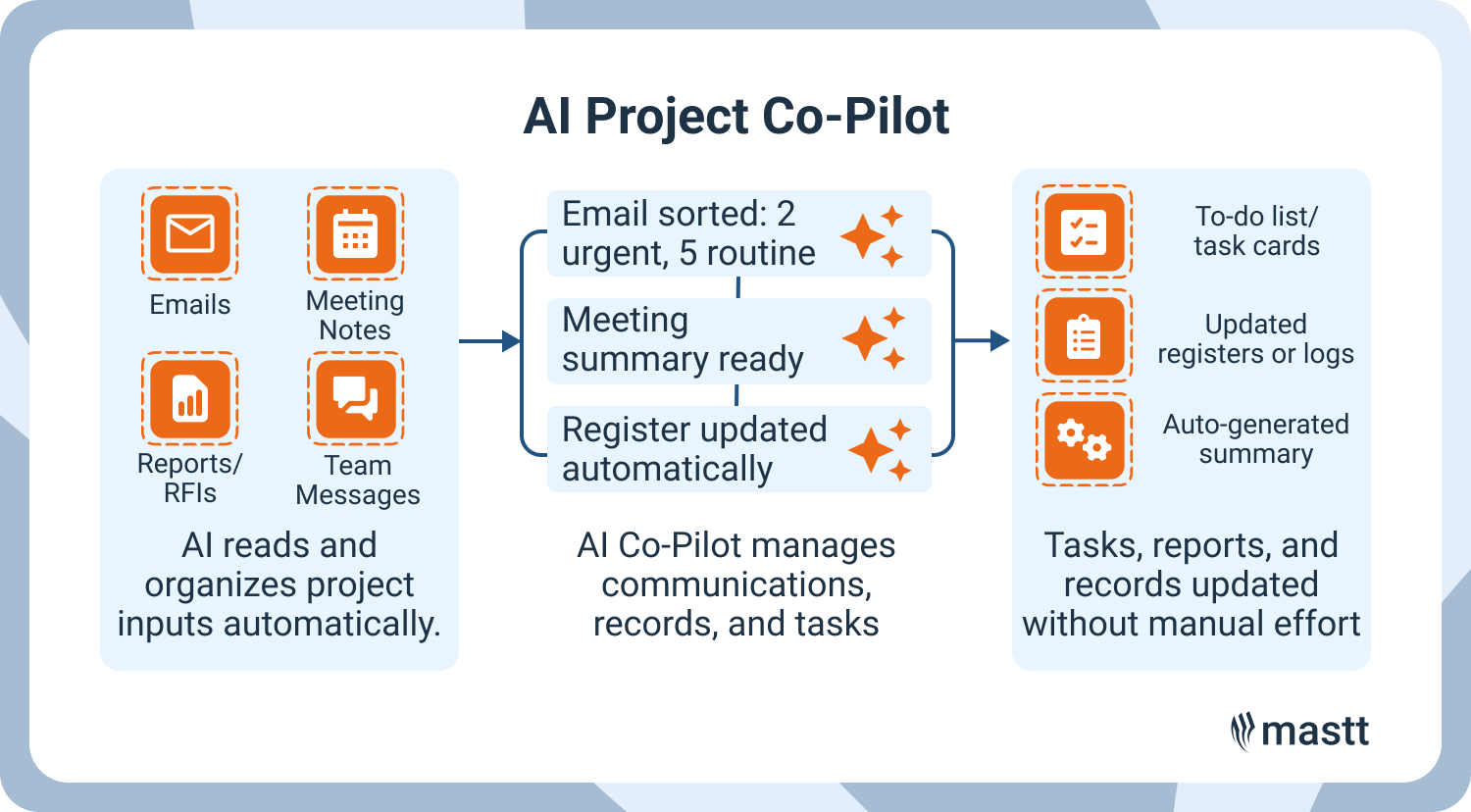
28. AI Record and Register Population Extracting and Updating Records in Real-Time
AI data extraction tools automatically pull information from correspondence, reports, and documents to keep records current. They remove the need for manual entry and improve accuracy in project registers and logs.
Example: An AI engine reads new supplier correspondence, extracts delivery updates, and updates the material tracking register within seconds.
29. Record Keeping and Audit Trail That Automates Project Logs
AI-driven digital systems record all actions, communications, and document changes automatically. This creates a reliable audit trail that supports accountability and compliance. It also reduces the effort needed to compile records during audits or reviews.
Example: A digital audit tool tracks every change in project files, linking actions to timestamps and users to ensure complete transparency.
30. Administrative Task Automation to Streamline Daily Project Tasks
AI automation tools manage repetitive administrative workflows such as report preparation, file categorization, and meeting scheduling. By removing manual steps, they allow teams to focus on high-value work that requires human judgment.
Example: An automation platform collects weekly progress data, fills in a standard report template, and routes it for manager approval automatically.
Intelligent Reporting and Insights for Real-Time Project Visibility
Among the most common AI use cases in construction are tools that automate reporting and unify project data. These tools connect data from different systems, giving teams a single source of truth for every project. Instead of waiting for manual updates, stakeholders can access accurate, data-driven insights anytime.
31. Automated Report Writing That Creates Reports from Live Project Data
AI-powered automation tools transform how reports are created. These systems automatically collect, validate, and organize project data to produce accurate, consistent updates. They reduce human error and save hours of manual work.
Example: An AI reporting tool compiles daily data from multiple systems and generates a visual performance report with key insights ready for review.
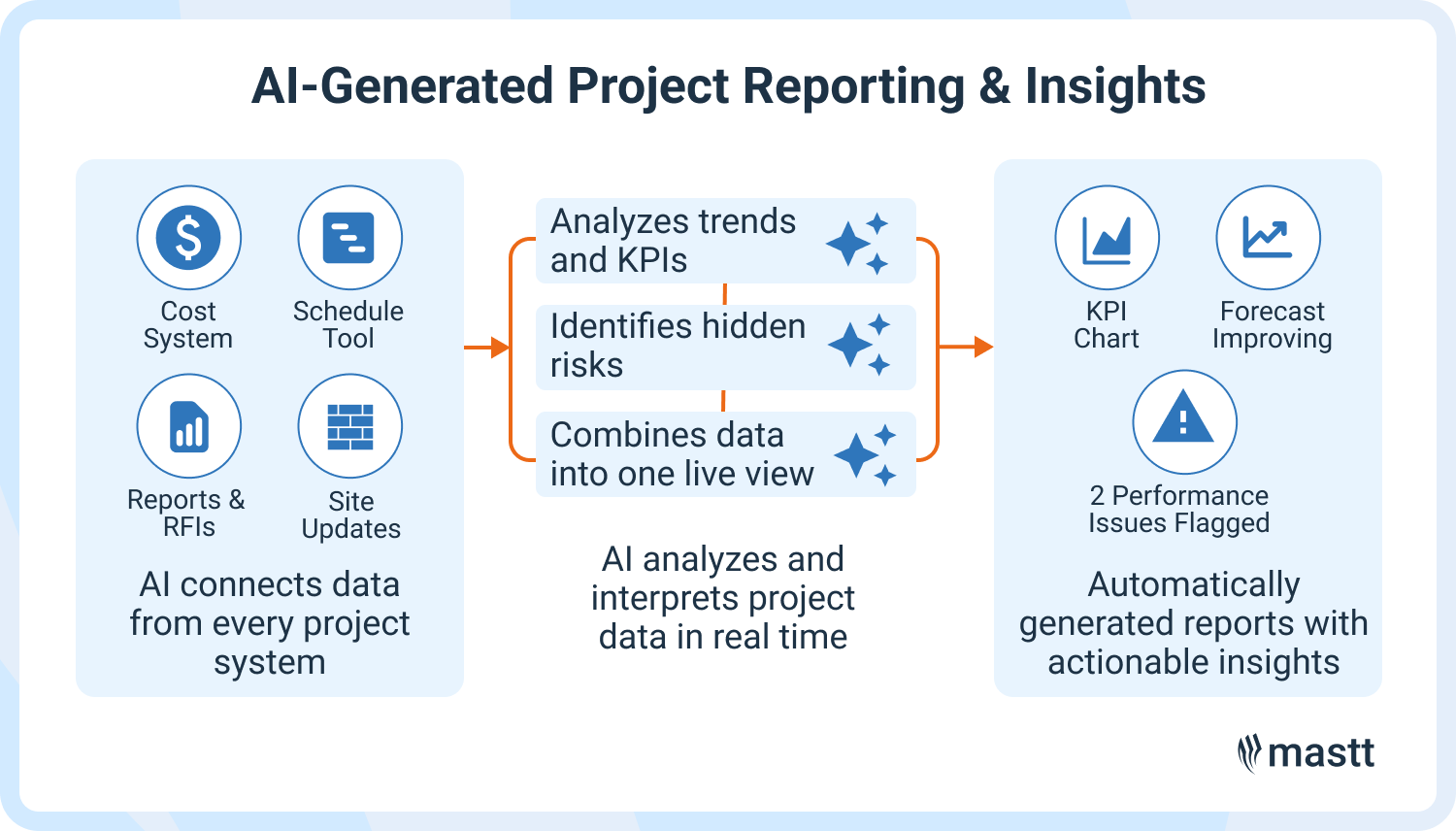
32. AI Knowledge Base to Unify All Project Data Into One Source
AI acts as the connective layer across fragmented systems. It links cost, schedule, and communication data into one centralized source for easy access and analysis. This unified view eliminates data duplication and ensures teams work from accurate, real-time information.
Example: An AI integration engine connects scheduling software and finance tools, revealing how a design change could affect material costs and timelines.
33. AI Dashboard and Reporting Builder Showing Live Project Performance
AI dashboards continuously pull live data and interpret results in real time. They don’t just show metrics but also explain trends, outliers, and potential risks. Project teams get a complete picture of performance without waiting for manual updates.
Example: A project dashboard powered by AI highlights slower task completion rates and identifies staff shortages as the cause, prompting quick corrective action.
34. KPI Analytics and Performance Insights Predicting Trends Early
Predictive analytics uncovers future trends from historical and real-time data. These AI systems detect early warning signs of schedule delays, budget issues, or performance drops. Project managers can act before problems escalate.
Example: Based on progress and cost data, an AI system predicts a two-week delay and alerts the project team to adjust resourcing immediately.
35. AI Insights on Current Projects That Identify Hidden Issues
AI-driven data intelligence scans large datasets to identify hidden risks. It analyzes construction contracts, correspondence, and reports for patterns that signal potential delays or cost overruns. This approach makes risk management proactive instead of reactive.
Example: An AI tool reviews meeting notes, finds repeated mentions of “supplier delay,” and flags it as a medium-risk event for follow-up.
36. Insights from Industry and Past Projects for Refining Future Forecasts
Machine learning algorithms learn from previous projects to improve forecasting accuracy. They update predictions as new data comes in, making cost and schedule forecasts dynamic and data-driven. The more the system learns, the more reliable it becomes.
Example: A forecasting AI compares new project data with hundreds of completed jobs and adjusts estimates to account for seasonal material shortages.
37. Integrated Knowledge and Learning System to Improve Accuracy Over Time
AI models evolve over time by learning from completed projects. They identify recurring patterns, validate assumptions, and refine predictions. This continuous improvement loop helps organizations make smarter, data-backed decisions for future projects.
Example: After analyzing results from multiple builds, an AI model learns that early procurement leads to better delivery times and incorporates that insight into future forecasts.
Automated Preconstruction and Tendering for Streamlined Bidding Processes
Preconstruction and tendering are gaining speed through AI-driven estimation and evaluation tools. Estimation engines, document analysis, and benchmarking models remove manual guesswork, allowing teams to price, compare, and recommend with precision and confidence.
38. AI Estimating Tool Analyzing Data to Deliver Accurate Estimates
AI estimation tools analyze historical data, market trends, and project parameters to calculate accurate cost predictions. They consider variables such as material prices, labor rates, and timelines to produce consistent results faster than traditional methods. Continuous learning improves their accuracy over time.
Example: A project manager enters basic project details, and the AI estimator instantly generates a cost breakdown using data from hundreds of similar completed projects.
39. Tender Review and Evaluation That Automates Bid Comparison and Scoring
AI tender evaluation systems assess bids using predefined criteria to remove human bias. They score submissions based on compliance, pricing, and qualitative responses. This ensures fair comparisons and faster procurement decisions.
Example: During a tender process, the AI system evaluates multiple bids, highlights missing information, and ranks them according to weighted scoring rules.

40. Proposal and Winning Work Support for Automating Bid Writing and Reviews
Proposal automation is among the emerging generative AI use cases in the construction industry. AI proposal assistants simplify bid preparation by drafting sections, checking for compliance, and optimizing language for clarity. They draw from previous proposals, project data, and templates to create polished submissions ready for review.
Example: A proposal manager uploads tender documents, and the AI assistant drafts responses tailored to each requirement, refining tone and structure for a professional finish.
41. AI Insights from Past Projects for Better Pricing and Win Rates
AI predictive analytics tools compare new bids against historical data to forecast outcomes and competitiveness. They assess pricing trends, win rates, and past supplier performance to guide smarter bidding strategies.
Example: Before submitting a bid, the AI benchmarking system analyzes similar tenders from the past five years and predicts the likelihood of success based on price and technical alignment.
Integrated AI Data Platforms for Connected Project Systems
Among all AI in the construction industry use cases, integrated data platforms are key to eliminating silos. By linking scheduling, cost, and reporting tools, AI ensures data flows freely across systems. Centralized intelligence improves visibility, reduces duplication, and gives every stakeholder live, accurate information.
42. Data Integration and Interoperability Connects Every Project Tool into One System
AI-driven data integration links multiple platforms into a single, connected environment. It synchronizes cost, schedule, document, and communication data automatically, removing silos and duplication. Teams gain a complete view of project performance through one interface.
Example: An AI integration hub connects scheduling, procurement, and finance systems so updates in one tool automatically appear across all others in real time.

43. Integrations and Data Pipelines Sync Data Across All Project Tools
A great example of AI use cases in construction is how automated data pipelines keep information fresh and reliable. These smart systems pull data from various project tools, clean it, and update reports instantly. The technology ensures everyone is working from the same accurate source of truth.
Example: Each night, an AI system gathers data from job-site apps and accounting software, updating project dashboards before the team starts their day.
If you’re looking for more AI use cases utilized by real construction professionals, check out the webinar below where Doug Vincent, CEO of Mastt, explores practical AI applications across the industry.
AI is Redefining How the Construction Industry Works
AI is already changing how construction projects are planned, managed, and delivered. It connects data, reveals insights, and helps teams make faster, better decisions at every stage.
As more firms adopt intelligent solutions, the industry moves toward a future of higher accuracy, efficiency, and collaboration. Now is the time to explore the best AI use cases in construction and see how platforms like Mastt can simplify your projects and set your team ahead of the curve.





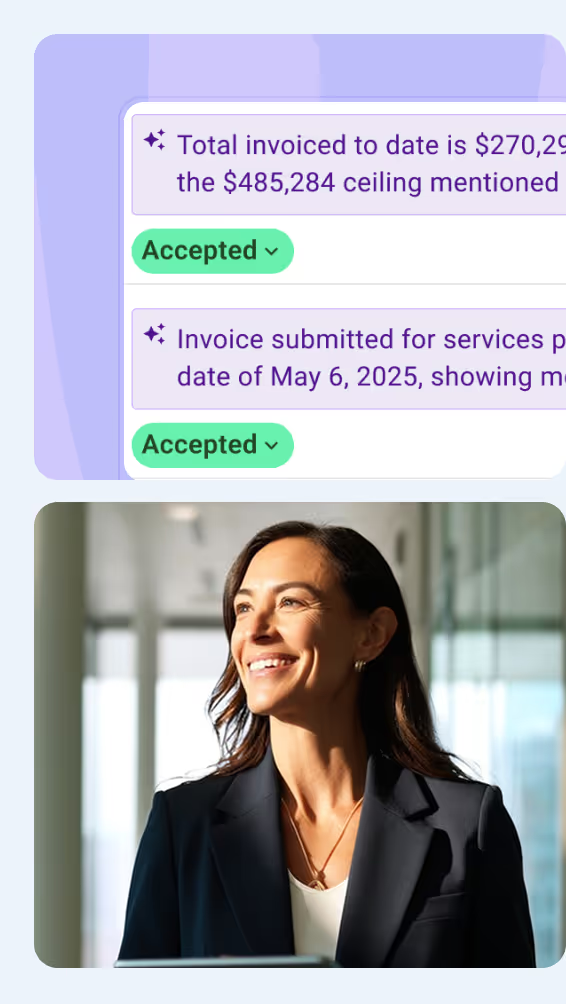
.avif)
